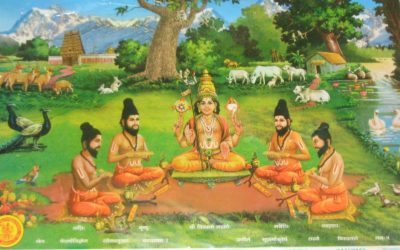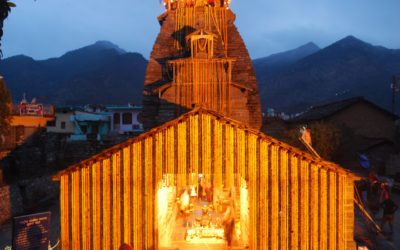The purpose of this article is to give focus to the Saraswati River as the true namesake for the Harappa Civilization as opposed to the use of the Indus River Valley nomenclature. It is time that due respect is given to the power of both the river and the goddess.
Multiple Evidences of the River Saraswati
Many organizations in India confirm that the Saraswati river not only existed but efforts are on in India to resurrect it from the deep recesses of the earth. These organizations include the Central Arid Zone Research Institute, Regional Remote Sensing Center and The Indian Space Research Organization (ISRO). Dr. J R Sharma, Chief General Manager of ISRO said, “ample scientific evidence from remote sensing to archaeological excavations reveal beyond doubt that the Vedic Saraswati River was flowing in Northwestern India, sub-parallel to the Indus River around 6,000 BC.”
The Saraswati River is mentioned approximately 71 times in the Rig Veda. It is praised in the Rig Veda as(2/41/16): “Best mother, best of rivers, best of goddesses.” In Book 10 Saraswati is powerfully invoked in the plural: “May the waters, the mother, cleanse us, may they who purify with butter, purify us with butter, for these goddesses bear away defilement. I come out of them pure and cleansed.”
The Saraswati River sustained and created the world’s earliest known civilization and its peoples. She started from the Himalayas and went through the Punjab plains of what is now Pakistan and India, through present day Rajasthan into the ocean. At her peak, the Saraswati sustained over five million inhabitants living in over thousand communities in villages, towns and the twin cities of Harappa and Mohenjo Daro.
The Saraswati River Civilization
The Hindu Goddess Saraswati is the goddess of knowledge, music, the arts, wisdom and learning. As the great Saraswati river, she gave abundance and plenty to the ancient alluvial plains along which her waters ran. In Mehrgarh, south of what was to become the city of Harappa, traces of a settled agricultural life has been found by archaeologists with evidence of granaries that stored barley and wheat. This evidence has been dated to about 9000 BC. David Frawley, in his book, “The Search for the Cradle of Civilization,” adds that the people of Mehrgarh were the first to grow cotton and weave it into cloth.
Also at Mehrgarh Dr. Roberto Macchiarelli, a paleoanthropologist, discovered dental drills and evidence of drill holes in the teeth of both male and female skeletal remains. This evidence is corroborated by Prof. Frayer in his find of nine skeletal remains. This means, that the Saraswati River people had the knowledge of dentistry thousands of years before any other civilizations learned about it.
Urbanization Thousands of Years Ago
The Saraswati River Civilization continued to flourish for centuries leading to urbanization and growth of cities. The most famous are the twin cities of Harappa and Mohenjo Daro the remains of which are dated to 3500 BC to 1500 BC. They reveal well-planned buildings constructed on a grid system facing in all cardinal directions, which some scholars say was built for astronomical pursuits. The bricks used for the homes and public buildings were all of uniform size and shape and were found in towns, villages, and cities all over the valley. Sophisticated engineers designed an intricate sewage system and many homes had bathrooms which included toilets connected to underground pipes leading out of the city. There were public bathing areas and the city was equipped with sump pumps. Archaeologists have found an abundance of jewelry and toiletry items and female figurines with intricate hairstyles that tell of a cleanliness and luxury conscious people.
Mohenjo Daro Seals
The voice of the Saraswati River Civilization, was the Rig Veda. The medium for the Rig Veda to communicate were seals made of soapstone and terracotta, many of which have been found in the site identified as the city of Mohenjo Daro. Also found were larger seals of copper 2.5 to 5 cm in diameter. Each seal depicts a different animal which include zebra, bears, tigers, elephants, to name a few. There are also etchings of different deities on numerous seals. Above each illustration on each seal is a pictographic type of script.
Decoding the Pictographic Script – Hidden Secrets of the Rig Veda
The secret of the pictographic seal script, which eluded scholars for decades, has now been deciphered. The credit for this goes to Dr. C.P. Trivedi who broke the code. He discovered that the pictographs are not communicating in a language as such, but were coded messages. They are “… cytological models for teaching. They explore the cellular genetic evolution in the earth with genetic recombination.” He continues, “I am proud to say that DNA was first discovered in India more than 18,000 years ago and their representation is engraved on seals that were found in an excavation in the Indus Valley. Not only DNA structure, but also the processes of cell division are illustrated clearly in the seals and tablets of rock in Mohenjo-Daro. The seals also represent the evolution of cosmic creation and man’s evolution.”
Dr. Trivedi has recognized that the seals are a written story taken from the Rig Veda in order to preserve for posterity the wisdom that the rishis (seers who from intense meditation received the sacred truths from the Cosmos) shared with humanity. From reading the Vedas he discerned that their knowledge had been transferred by the ancients on to the tablets and soapstone artifacts as pictorial documentation for the public. Confirming this belief, larger copper seals were found with the same pictorial images as on the tablets and soapstone seals.
Higgs Boson Phenomena – Was Known 18,000 Years Ago
Interestingly, C.P. Trivedi shares that the Rig Veda was passed down through hymns as far back as 18,000 years ago. Dr. Trivedi not only decoded the hymns from the Rig Veda, but also the writings from the seals, and matched them up as parallel teachings. He further says that the seals contain scientific information that is far ahead of what scientists know today.
From his readings of the Rig Veda and the seals, he asserts that there are answers to the questions that theoretical physicists today, involved with the Higgs Boson phenomena are answering. Dr. Trivedi declares that the Rig Veda has within its hymns the description as to how particles change into matter. Dr. Trivedi asserts that the Higgs Boson “god particle” has its corollary in the Rig Veda, where it is called, “Hiranyagarbha-the Golden Egg.” In Hindu cosmology, it is known as the source of the creation of the universe.
The Rig Veda contains in its hymns vast knowledge about astronomy and the heavens which was also translated and codified into the seals. Most importantly, the Rig Veda contains the very spiritual backbone of Hinduism. This certainly had to be a key element for the centuries of peace that pervaded the communities of the Saraswati-Harappan civilization.
2000 Years of Peaceful Civilization
“There is no evidence that any of the Harappan cities were ever burned, besieged by an army or taken over by force within.” Annalee Newitz writes in the article, ‘Did This Ancient Civilization Avoid War for 2,000 Years?” Furthermore, there is no evidence in artwork in Harappa that depicts war or battles and there are no monuments to war. In contrast, Mesopotamia, at relatively the same time tells the story of bloody warfare and enslavement, in their inscriptions on stone monuments.
Conclusion
The people in the Saraswati River Civilization experienced all the benefits of a civilization. In addition, they had an existence based on spiritual understanding, material comfort, and conflict-free living. They were a people who had the technology and scientific knowledge that far surpassed that of modern times. The fact that there was no indication of warfare means peoples of the Saraswati River Civilization had a deep knowledge and understanding of the human condition and had an evolved concept of harmony and how to respect their fellow human beings. This is an accomplishment that we in the 21st century are nowhere close to even imagining, let alone achieving it.
By connecting the Mohenjo Daro seals to the Rig Veda, Dr. Trivedi has clearly pushed the Saraswati River Civilization dates back by an astonishing 18,000 years. However, in several references of His Holiness Paramahamsa Nithyananda we do know the Vedic Civilization is at least 60,000 years old. Clearly, the theory of Mesopotamia, Egypt and Indus Valley being the oldest civilizations needs re-examining. It must give way to a more thorough research of Vedic times – beyond archeology, inscriptions, coins or even skeletal dental remains!
Source
1.In Search of The Cradle of Civilization by George Feurstein
2.Did This Ancient Civilization Avoid War for 2,000 Years Amalee Newitz
3.A New Type of Copper Plate from the Indus Valley by Visant Shinde and Rick Willis
4.Gods, Sages and Kings by David Frawley
5. Vedic Genetics in the Indus Valley by C.P. Trivedi
6. Vedic Cell Biology with Life Energy and Rebirth by C.P. Trivedi
7. UPSC Times of India August 13, 2004
8. New York Times Science Section “Man Was Enduring Dentist’s Drill 2,000 Years Ago by Kyle Jarrard





0 Comments